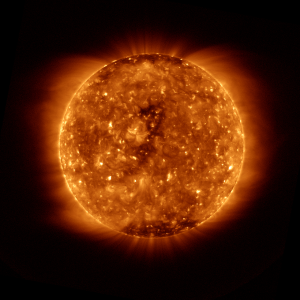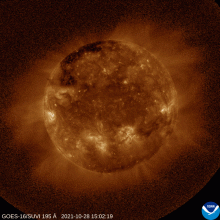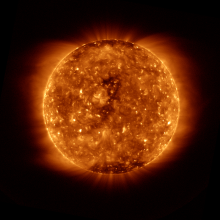This ultraviolet image shows the Sun in 2019, during solar minimum, a period during which it produces few sunspots or solar flares. Activity is increasing, with a maximum forecast for 2025. The number of sunspots and other magnetic features has been above predictions for this cycle. [NOAA]
You are here
Unruly Sun
The Sun isn’t behaving itself. Most forecasts for its current cycle said it should be quiet. But it hasn’t been. And the level of activity has been picking up.
The Sun goes through an 11-year magnetic cycle. At the cycle’s peak, the Sun is covered with more of the dark magnetic storms known as sunspots. It also produces more big outbursts of energy and particles.
Those outbursts can have a big impact on our technology. They can damage or destroy orbiting satellites, disrupt air traffic and radio transmissions, and knock out power grids on the surface. So scientists keep an eye on solar activity. And they produce both short-range and long-range forecasts to help operators know when to take precautions.
The last cycle was quiet. There were periods of days or weeks when there were no sunspots at all. That cycle ended in late 2019.
Forecasters expected the new cycle to be just as quiet. They expected it to peak in mid-2025, with an average maximum of about 115 daily sunspots — about a third less than the average peak.
From the beginning, though, the new cycle has been more active. There have been more sunspots, and more of the big outbursts known as solar flares. That includes several that are in the most powerful category — like category 5 hurricanes.
As with all forecasts, we can’t be sure what’ll happen next. But it sure looks like we can expect the Sun to be even more unruly over the next few years.
Script by Damond Benningfield
Get Premium Audio
Listen to today's episode of StarDate on the web the same day it airs in high-quality streaming audio without any extra ads or announcements. Choose a $8 one-month pass, or listen every day for a year for just $30.






